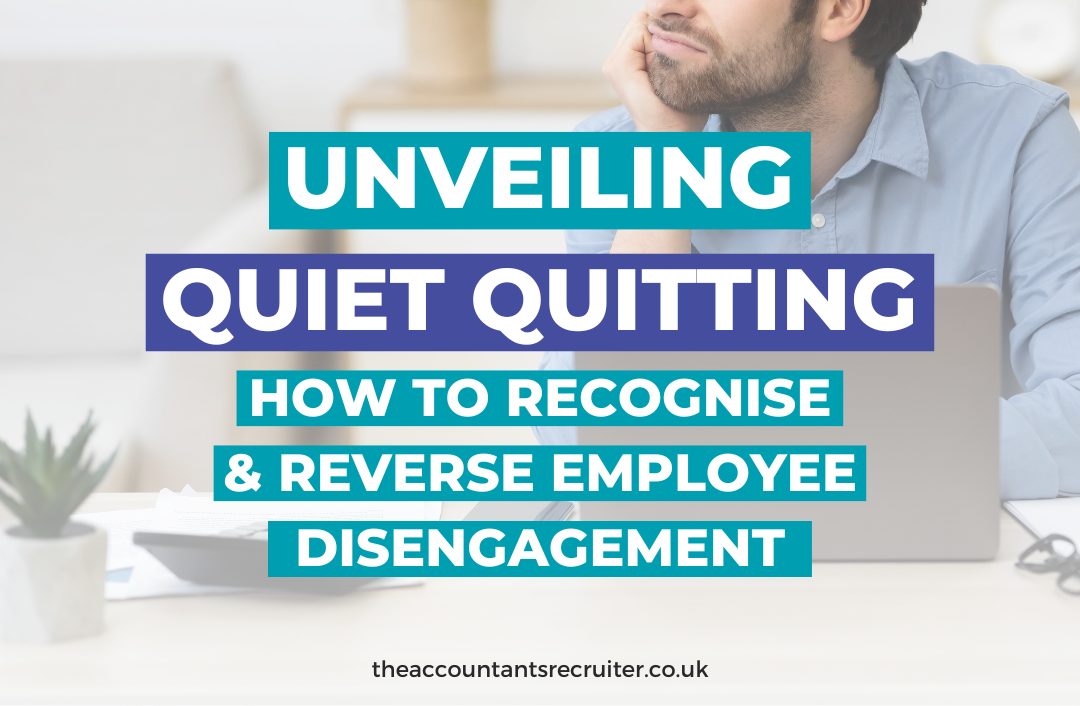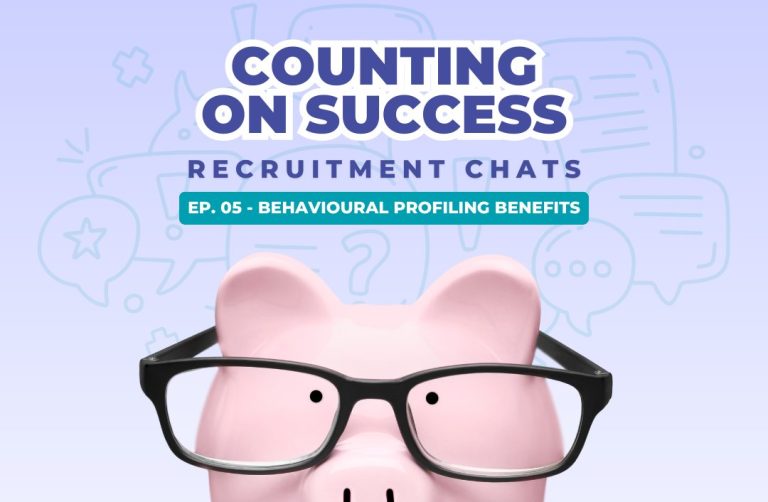Unveiling Quiet Quitting: Strategies to Recognise & Reverse Employee Disengagement
Does it seem like your employees are slipping away unnoticed? Do you struggle to retain talent and keep your team motivated? If the answer is yes, then you might be facing a problem known as quiet quitting. In this blog post, we’ll share what quiet quitting is, why it’s become more common, and, importantly, how to combat it.
What is quiet quitting?
The meaning of "quiet quitting" is up to interpretation. Some say it doesn't necessarily mean your employees will quit their jobs, and others say it's the beginning of the end.
The term itself refers to employees who show:
- Diminished initiative (just putting in allotted hours and getting their due pay) and/or refusal to take on more work or obligations
- Reduced communication
- Quality of work deterioration
- Increased absenteeism
- Lack of interest in their career development
These tendencies are concerning as many accountancy firms rely on employees to work many more hours than they are compensated for during the busy season.* So employers need to be aware of how this could cause their employees to disengage. How can you support them during this period? Can you do more to instil a culture of teamwork and self-development?
Unsurprisingly, several firms have found a correlation between the early-career hustle and eventual partner potential. This means keeping your employees happy, engaged and motivated is key.
*It is important to note that the signs of quiet quitting may be signs of poor mental health. Having regular check-ins with your team members is imperative at any time of year and should be a safe space for them to let you know how they are doing.
Cause for concern over quiet quitting
According to one theory, the Great Resignation and pandemic inspired the biggest Quiet Quitting movement. Why? This phenomenon allows people to regain autonomy over their careers and personal lives after experiencing prolonged job insecurity. There is always the possibility of a "quiet resignation" if an employee doesn't feel they have the freedom to leave for any reason formally, but during times of uncertainty, this can be magnified.
Most quiet quitters tend to be younger
If you have read any articles on quiet quitting, you might notice quiet quitters that can lean towards younger generations (e.g. Generation Z, recent school leavers). They may stop showing up in their work or disengage from their jobs. In the subsequent 12-18 months, they will then either find new employment or launch their own business. Although quiet quitting might mean different things to different people, it appears to be the initial stage of leaving a position. These findings are consistent with a recent poll conducted by Gallup, where more than half (54%) of workers born after 1989 are disengaged.
Curious about Gen Z?
Check out the Counting On Success podcast episode about recruiting and retaining Gen Z accountancy talent.
Remote working is making this easier
For as long as taxes have been collected, there has always been a certain percentage of workers who can get away with doing the bare minimum. As far as I know, it has always been the case. The rise of remote labour has just made it simpler for low-level workers to avoid detection by upper-level management. It's no surprise then that resigning in secret is less of a hassle without anyone in upper management noticing.
Be careful of the impact on existing employees
Conflict in the workplace can also be caused by people departing quietly. After all, animosity will rapidly grow if everyone in the team isn't doing their part. Be wary of this as it can cause your best employees to become dissatisfied with their current circumstances and seek employment elsewhere.
How to combat quiet quitting
To what extent does your company suffer from "quiet departures," and what steps may be taken to prevent them? To determine why employees are essentially leaving without much of a trace, you should start with the company's leadership and culture and ensure you adhere to the following tips:
Embrace a hybrid model of working
The most senior employees in your company are often accustomed to putting in long hours behind a desk. They may say things like, "Get people back into the office" as a solution to the problems with employee engagement and morale. While appealing at first, this strategy is likely to cause more quitting than content.
Our candidates report a strong desire for work-life balance as one of their top priorities. They would like to "have their cake and eat it too." That is, they would like to have the option of coming into an office some days but working remotely on other days. Indeed, several workplace studies corroborate this. Some recent statistics include:
- Deloitte found that by the year 2020, over half of all professionals placed the highest importance on remote work and flexible work hours.
- Deloitte Australia conducted a poll in 2022 and discovered that 93 percent of respondents valued their own physical, emotional and mental health as highly as their own financial compensation.
- When given the option, 78% of employees would rather work a blended schedule or from home.
Take care of your partners and top earners first
Your leading fee earners and partners typically work long hours. They may have put in as many hours as necessary to get the job done, no matter the cost to their health or personal life. How many of your friends and associates have been divorced? Or make it seem as though they gave up their lives and their waistline for the cause? Is it any surprise that many of the younger workers are looking up and not aiming to be the next partner in your firm?
In many companies, the culture of a team or office is determined by the example set by partners and top fee earners in terms of work hours and limits. But if junior staff see that their superiors value self-care — for example, by taking proper time off while on vacation or rarely working on weekends — that will waterfall down the rest of the company. Younger workers are less likely to quietly quit if they believe that upper management values their time off.
Allow workers their vacation time
Quiet quitters advocate for strict time limits so as not to toil away at the office on nights, weekends or holidays. Therefore, for businesses to prevent quiet resignations, they should reduce the number of times young workers are asked to "pull an all-nighter at work" or dedicate part of their weekends to company business. To avoid staff needing to respond to urgent emails on the weekend or after hours, scheduling tools can be implemented. A scrutiny of the normative demands made on staff members should also be taken.
Workers are not resources to be overworked, even though they must be compensated for their time. The business model of any company that habitually expects its workers to charge for more than six hours per day has to be examined closely.
Food for thought on your approach
Increased productivity is just one of the many advantages of hybrid work arrangements, but the lack of strong management and leadership (including communication) in an organisation is immediately brought to light. Employees may soon begin to feel demoralised and their work to be meaningless due to ineffective management and leadership.
According to Gallup's study, a large percentage of young workers do not see their jobs as meaningful. This is the generation that for 2-3 years of their formative career have been working from home for huge chunks of time. It's really no surprise that many of our younger workers are contemplating quitting quietly, given the reality that many tax practices have a matrix structure in which ties between senior managers and their direct subordinates are fragile.
Hybrid work styles necessitate a higher level of planned and deliberate conversation amongst coworkers. Since employees are not constantly present, management by walking around is ineffective. For this reason, an audit of the frequency and timing of internal company communications is necessary. So make sure to look at everything from how upper-level managers talk to their subordinates to how team and project leaders and counselling managers talk to their subordinates. After all, it's tough to fade away if you have reason to feel that someone is keeping tabs on your progress. (To be clear, this is not about micromanaging but actually knowing what is going on in the workplace and showing care for your team.)
Don’t let quiet quitting sneak up on you
Quiet quitting is a real phenomenon that can have serious consequences for your team’s success. As a manager, it is up to you to recognise the signs and take steps to address them. By creating an environment that encourages open communication and building strong relationships with your employees, as well as providing clear expectations and feedback, you can help create a workplace where everyone feels valued and motivated. With these strategies in place, you can prevent quiet quitting before it starts and/or mitigate its effects if it does occur.
The original version of this article appeared on our sister company’s site.







